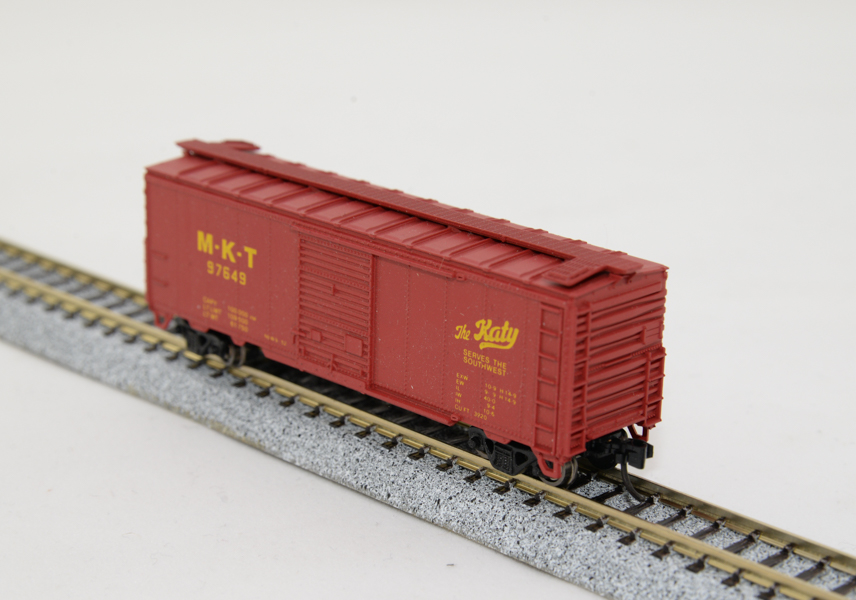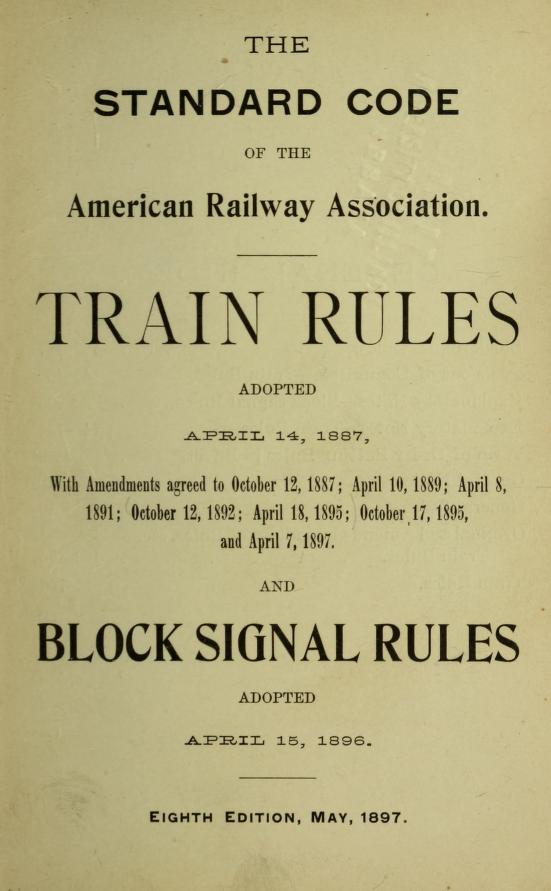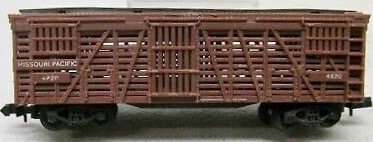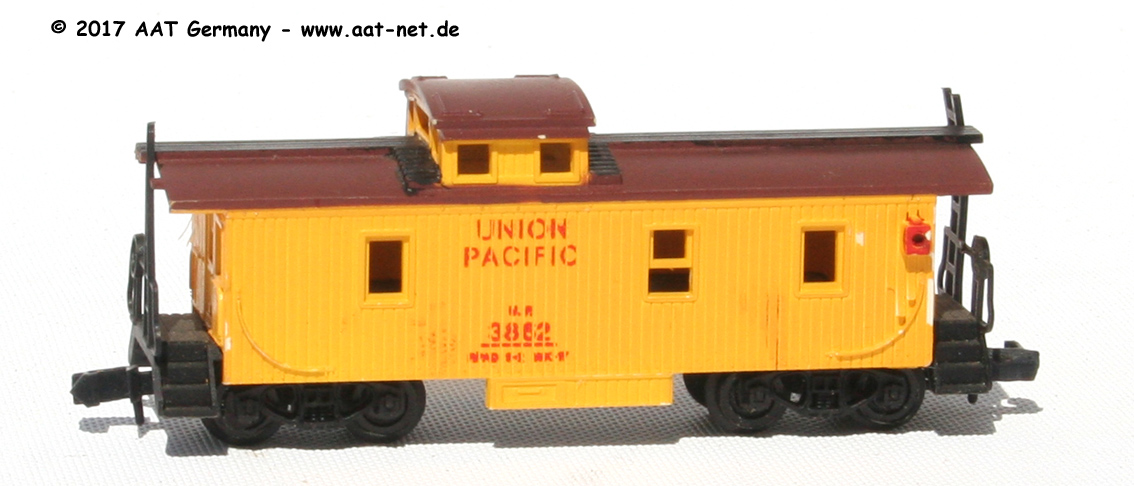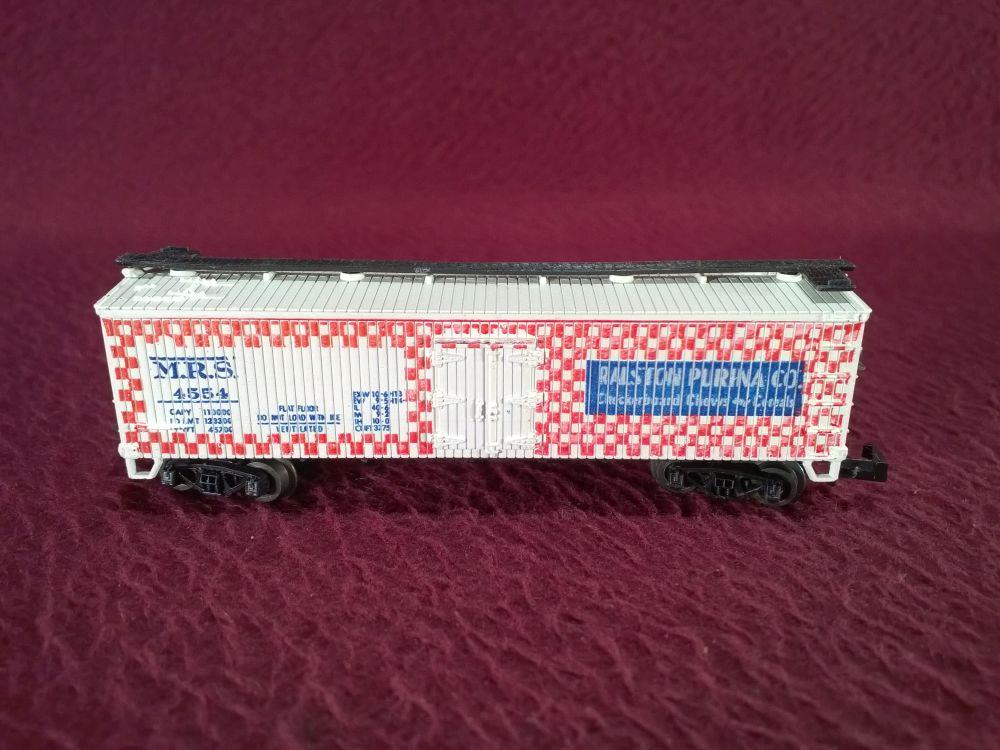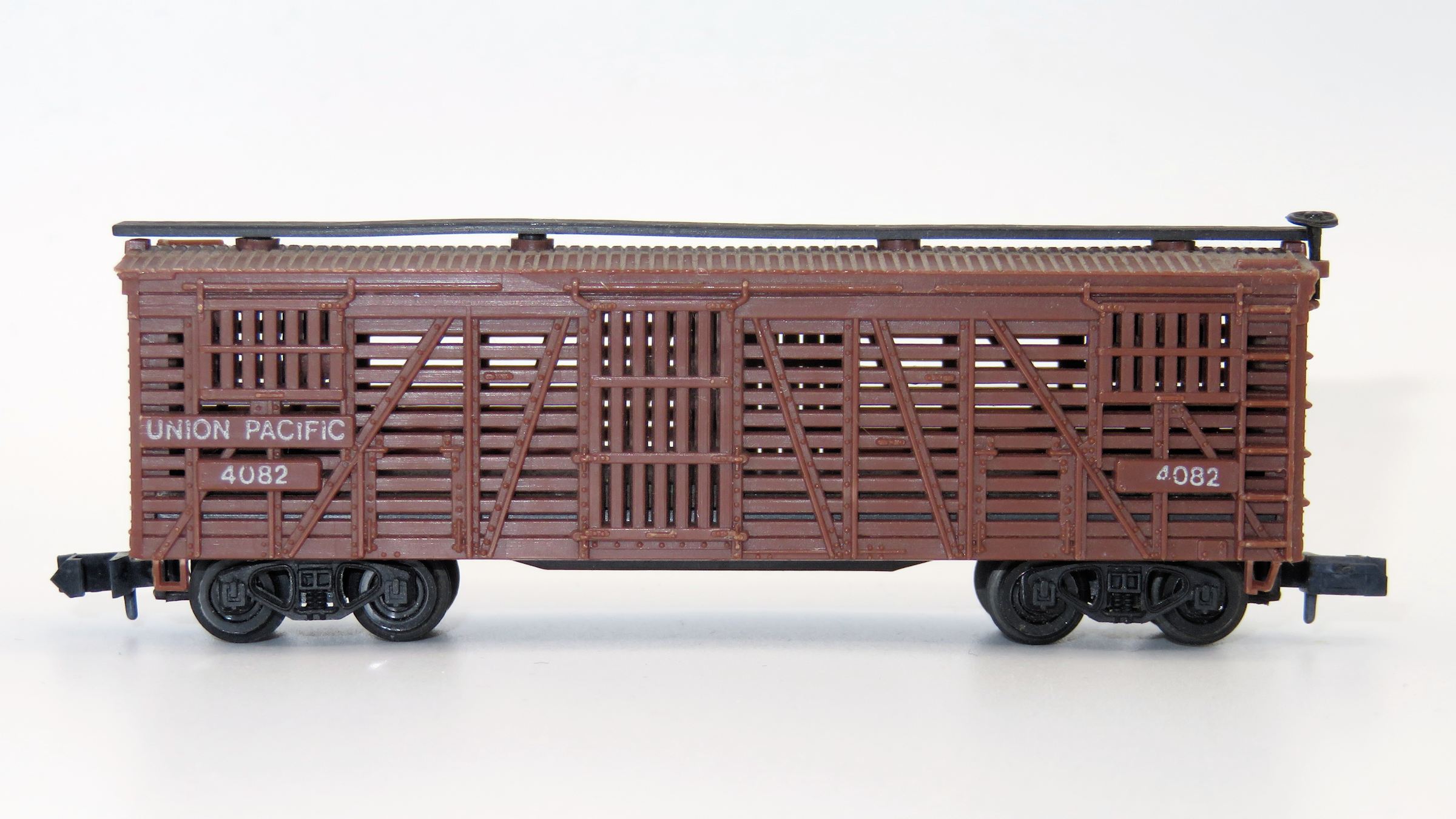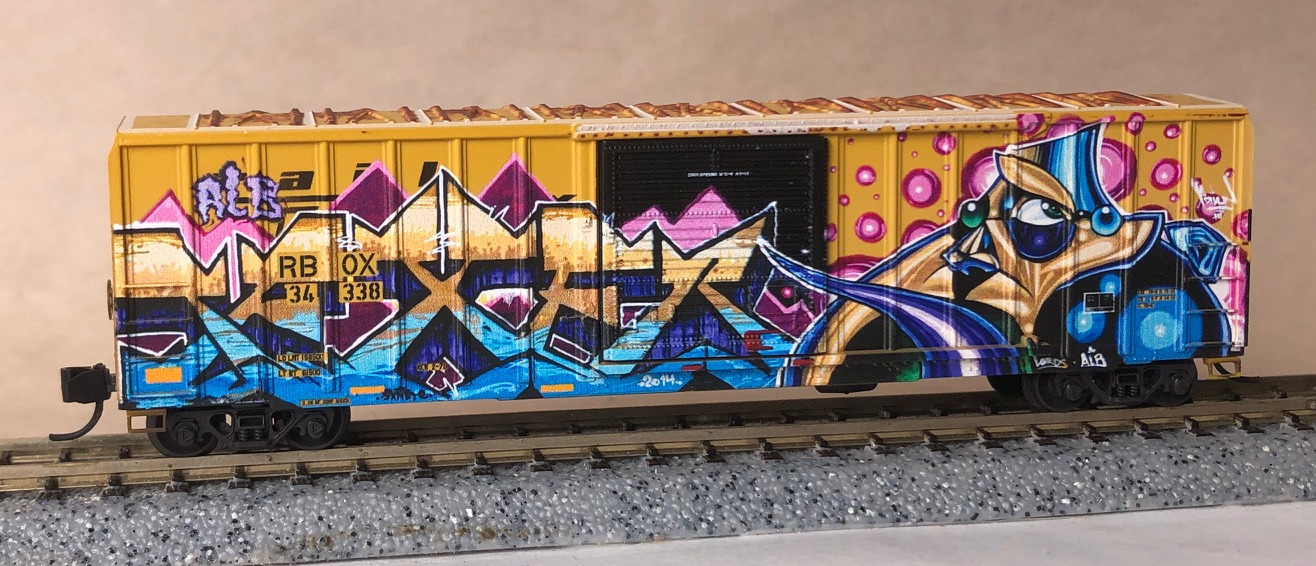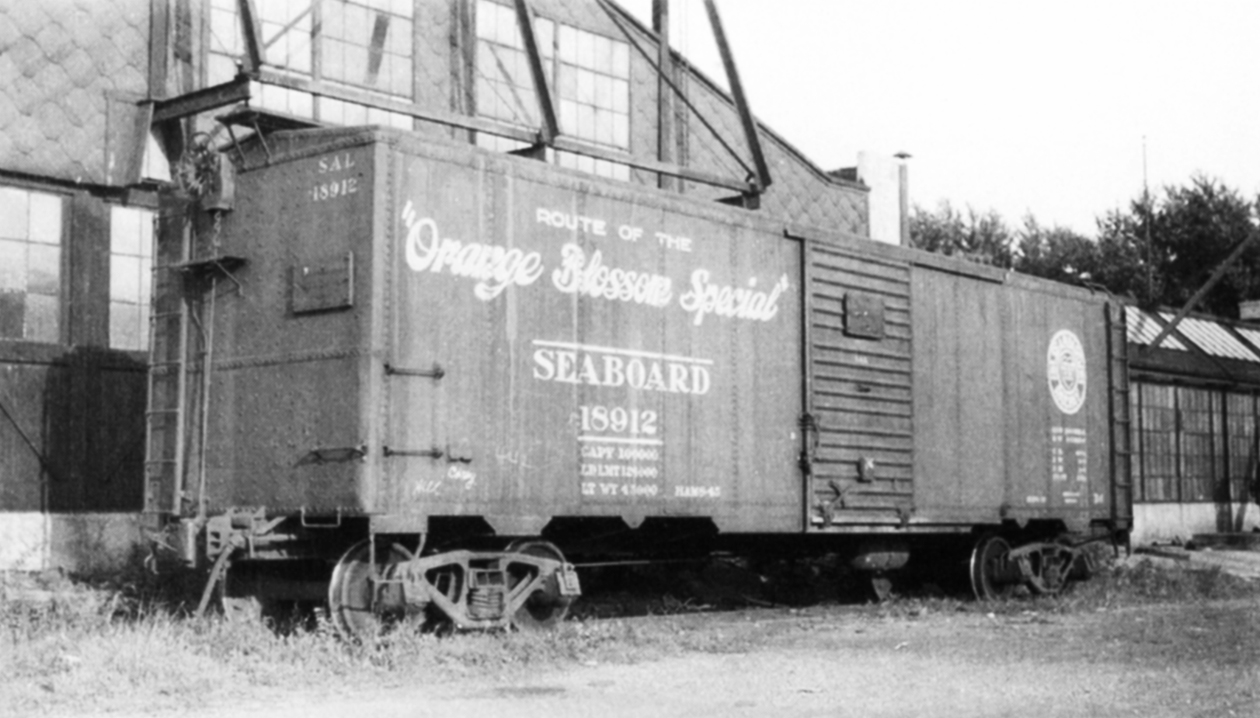Model Information: These cars were made by Roco under contract for Trix for the Minitrix product line. This car has been imported by Aurora, Model Power, and directly by Minitrix under their own label as well as by Aurora under the "Postage Stamp" label (Aurora and Model Power). The same cars were available both individually as well as parts of sets. This body style represents the single-sliding-door version.
Prototype History: The first all-steel box car adopted as standard by the American Railway Association or ARA was a sound design, but unfortunately adopted near the depth of the Depression. Accordingly, not many railroads had the funds to buy this design, and orders only totaled 14,500 cars. But some of the railroads which did buy the 1932 car bought substantial numbers of them, and they are significant railroads: the Missouri Pacific (with subsidiaries, purchasing over 3000 cars) and the Seaboard (2000 cars). The Seaboard cars are especially interesting because the railroad chose to use the flat steel roof and ends reminiscent of the ARA’s proposed all-steel box car of 1923 (not adopted as standard), and widely used on the Pennsylvania X29 and Baltimore & Ohio M-26 classes.
In the early 1920's the Pennsylvania Railroad developed plans for a steel-sheathed box car and designated the design X-29. Production of this design began in 1924 and lasted into 1934. During this time period almost 30,000 Pennsylvania X-29 cars were built. Not all X-29's were the same. Their parts components varied from the original cars almost immediately. Variations included: frame components, brake systems, side sheathing, ends and doors just to mention the major changes. The 1924 X-29 was produced with the split K-brake or AB brake (added later), flat ends and side sheathing that has the 2nd to last panel from each end of the car overlapping its adjacent panels.
The ARA / X-29 box cars were noticeably shorter in height (8'-7" inside height) than later cars. .
There are many photographs showing X-29's lasting into Penn Central maintenance of way service.
More on PRR X-29 on this web site.
In the early 1920's the Pennsylvania Railroad developed plans for a steel-sheathed box car and designated the design X-29. Production of this design began in 1924 and lasted into 1934. During this time period almost 30,000 Pennsylvania X-29 cars were built. Not all X-29's were the same. Their parts components varied from the original cars almost immediately. Variations included: frame components, brake systems, side sheathing, ends and doors just to mention the major changes. The 1924 X-29 was produced with the split K-brake or AB brake (added later), flat ends and side sheathing that has the 2nd to last panel from each end of the car overlapping its adjacent panels.
The ARA / X-29 box cars were noticeably shorter in height (8'-7" inside height) than later cars. .
There are many photographs showing X-29's lasting into Penn Central maintenance of way service.
More on PRR X-29 on this web site.
Road Name History: 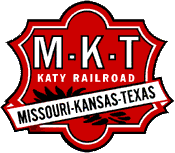 The Missouri-Kansas-Texas Railroad (reporting mark MKT) is a former Class I railroad company in the United States, with its last headquarters in Dallas. Established in 1865 under the name Union Pacific Railway, Southern Branch, it came to serve an extensive rail network in Texas, Oklahoma, Kansas, and Missouri. In 1988, it merged with the Missouri Pacific Railroad and is now part of Union Pacific Railroad.
The Missouri-Kansas-Texas Railroad (reporting mark MKT) is a former Class I railroad company in the United States, with its last headquarters in Dallas. Established in 1865 under the name Union Pacific Railway, Southern Branch, it came to serve an extensive rail network in Texas, Oklahoma, Kansas, and Missouri. In 1988, it merged with the Missouri Pacific Railroad and is now part of Union Pacific Railroad.
In its earliest days the MKT was commonly referred to as "the K-T", which was its stock exchange symbol; this common designation soon evolved into "the Katy".
The Katy was the first railroad to enter Texas from the north through Denison, Texas. Eventually the Katy's core system would grow to link Parsons, Fort Scott, Junction City, Olathe, and Kansas City, Kansas; Kansas City, Joplin, Jefferson City, and St. Louis, Missouri; Tulsa and Oklahoma City, Oklahoma; Dallas, Fort Worth, Waco, Temple, Austin, San Antonio, Houston, and Galveston, Texas. An additional mainline between Fort Worth and Salina, Kansas, was added in the 1980s after the collapse of the Chicago, Rock Island and Pacific Railroad; this line was operated as the Oklahoma, Kansas and Texas Railroad (OKKT).
At the end of 1970, MKT operated 2623 miles of road and 3765 miles of track.
From Wikipedia

In its earliest days the MKT was commonly referred to as "the K-T", which was its stock exchange symbol; this common designation soon evolved into "the Katy".
The Katy was the first railroad to enter Texas from the north through Denison, Texas. Eventually the Katy's core system would grow to link Parsons, Fort Scott, Junction City, Olathe, and Kansas City, Kansas; Kansas City, Joplin, Jefferson City, and St. Louis, Missouri; Tulsa and Oklahoma City, Oklahoma; Dallas, Fort Worth, Waco, Temple, Austin, San Antonio, Houston, and Galveston, Texas. An additional mainline between Fort Worth and Salina, Kansas, was added in the 1980s after the collapse of the Chicago, Rock Island and Pacific Railroad; this line was operated as the Oklahoma, Kansas and Texas Railroad (OKKT).
At the end of 1970, MKT operated 2623 miles of road and 3765 miles of track.
From Wikipedia
Brand/Importer Information: Con-Cor has been in business since 1962. Many things have changed over time as originally they were a complete manufacturing operation in the USA and at one time had upwards of 45 employees. They not only designed the models,but they also built their own molds, did injection molding, painting, printing and packaging on their models.
Currently, most of their manufacturing has been moved overseas and now they import 90% of their products as totally finished goods, or in finished components. They only do some incidental manufacturing today within the USA.
Important Note: The Con-Cor product numbering can be very confusing. Please see here in the article how to properly enter Con-Cor stock numbers in the TroveStar database.
Currently, most of their manufacturing has been moved overseas and now they import 90% of their products as totally finished goods, or in finished components. They only do some incidental manufacturing today within the USA.
Important Note: The Con-Cor product numbering can be very confusing. Please see here in the article how to properly enter Con-Cor stock numbers in the TroveStar database.
Manufacturer Information:  The company was founded in 1960 by Ing. Heinz Rössler and started with a plastic Minitanks series of military vehicles. After export to the USA became successful, the model line was expanded with model trains in HO scale and the smaller N scale. TT scale was also subsequently added to the product line. The model rail product line covers many European countries including Germany, Belgium, Luxembourg, France, Spain, Austria, Italy, Switzerland, Sweden and the Netherlands, and also the USA.
The company was founded in 1960 by Ing. Heinz Rössler and started with a plastic Minitanks series of military vehicles. After export to the USA became successful, the model line was expanded with model trains in HO scale and the smaller N scale. TT scale was also subsequently added to the product line. The model rail product line covers many European countries including Germany, Belgium, Luxembourg, France, Spain, Austria, Italy, Switzerland, Sweden and the Netherlands, and also the USA.
On July 15, 2005 ROCO Modellspielwaren GmbH was declared bankrupt. From July 25 the company continues as Modelleisenbahn GmbH, but still uses the Roco brand and associated logo. On October 1, 2007, distribution of the 'Minitank' product series was assigned to the German model car manufacturer Herpa.
Since February 2008 Modelleisenbahn also owns Fleischmann, which like Roco had gone bankrupt. The two companies continue as separate brands under Modelleisenbahn GmbH, while benefiting from economies of scale through joined development projects, marketing and procurement.
From Wikipedia

On July 15, 2005 ROCO Modellspielwaren GmbH was declared bankrupt. From July 25 the company continues as Modelleisenbahn GmbH, but still uses the Roco brand and associated logo. On October 1, 2007, distribution of the 'Minitank' product series was assigned to the German model car manufacturer Herpa.
Since February 2008 Modelleisenbahn also owns Fleischmann, which like Roco had gone bankrupt. The two companies continue as separate brands under Modelleisenbahn GmbH, while benefiting from economies of scale through joined development projects, marketing and procurement.
From Wikipedia
Item created by: CNW400 on 2018-08-31 10:35:16. Last edited by gdm on 2021-03-05 07:12:49
If you see errors or missing data in this entry, please feel free to log in and edit it. Anyone with a Gmail account can log in instantly.
If you see errors or missing data in this entry, please feel free to log in and edit it. Anyone with a Gmail account can log in instantly.


